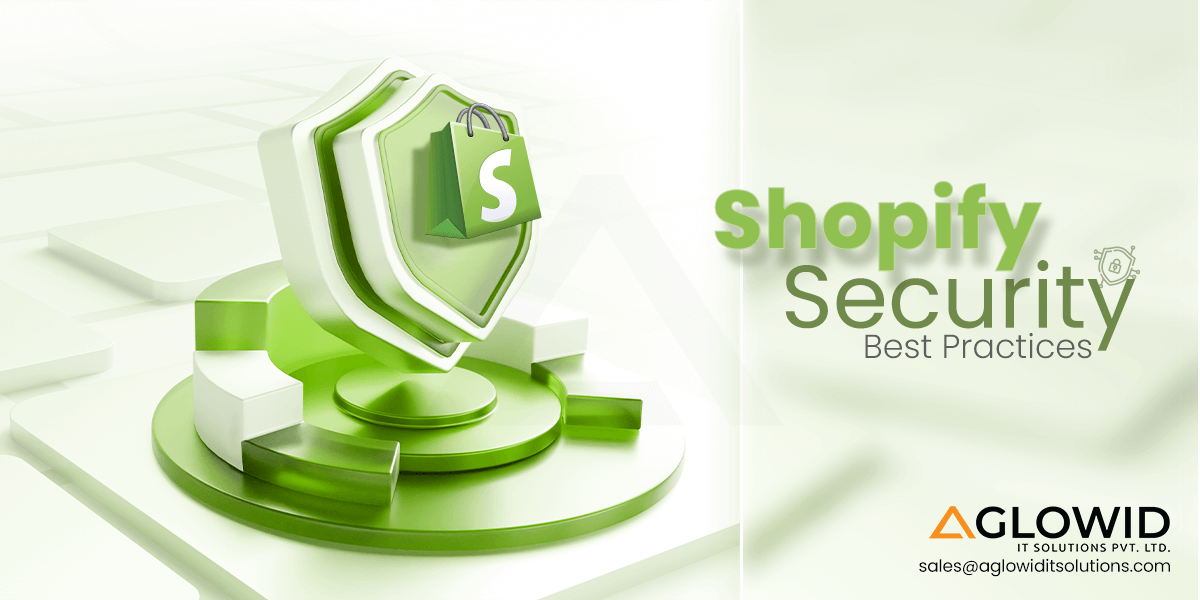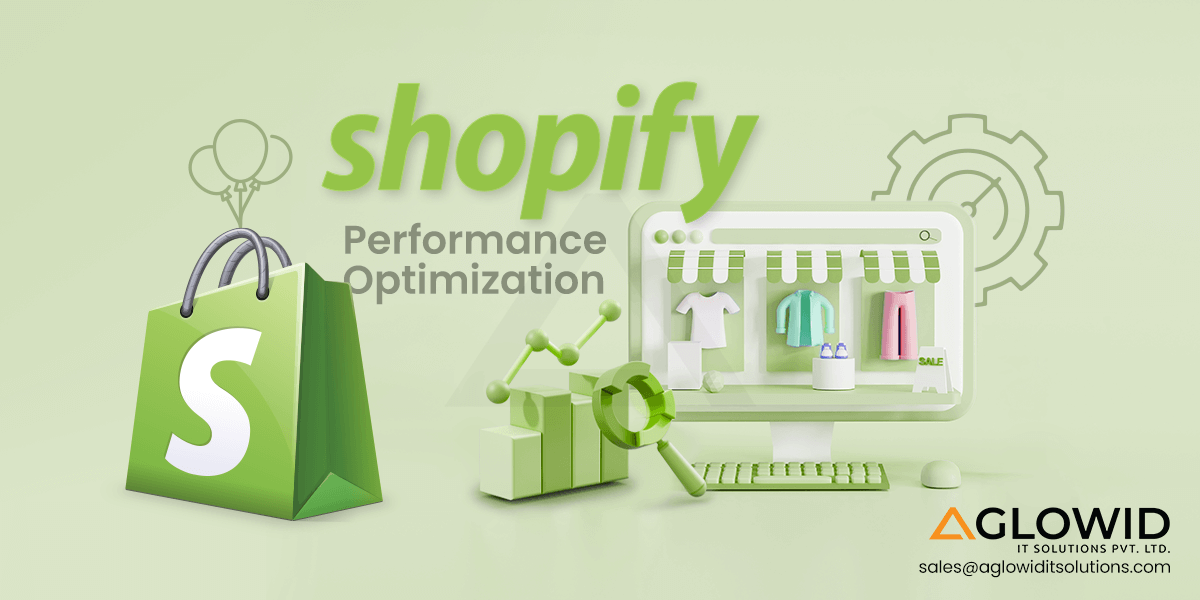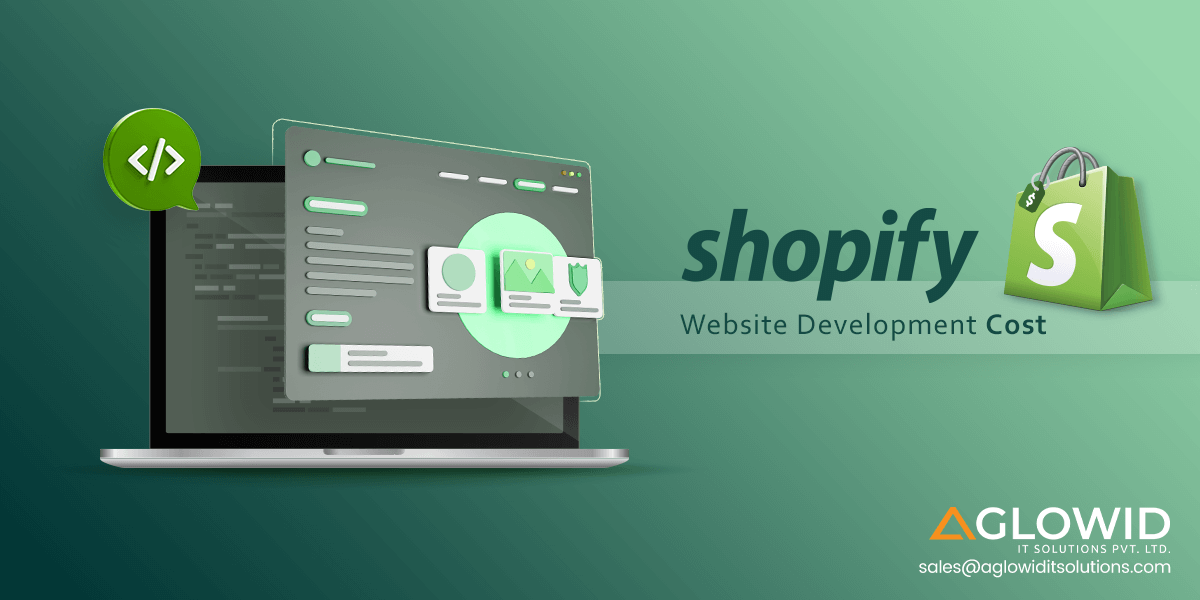Quick Summary:
Have a Shopify eCommerce store that isn’t giving you the numbers or conversion you expected? Are you looking for ways to rank your Shopify store on Google SERP results for intended keywords? Shopify SEO can be tricky if not understood well, so we have broken everything down in this logical and easy-to-follow Shopify SEO guide.
Shopify is one of the most popular ecommerce platforms powering various ecommerce stores such as Kylie Cosmetics, and Gymshark. As we can see, Shopify can be used for setting up an ecommerce store for various industries such as Fashion, Editorials, Streaming and even Fitness.
However, Shopify isn’t only a preferred ecommerce platform for established players. Many SMEs and startups also use Shopify to power their ecommerce store. According to Shopify – there are millions of Shopify merchants from over 175 countries worldwide.
According to Oberlo, the average ecommerce conversion rate were at 1.62% and and In US, the average conversion rate for mobile devices is 2%, whereas for desktops it is more than 3%. In another study by Littledata, Shopify stores had an average conversion rate of 1.4% in September 2022. Shopify stores producing less than 0.4 % conversion rate fall in the worst 20% of Shopify stores, whereas if your Shopify store can generate more than 3.4% conversion rates, it puts you in the top 20% of Shopify stores. So, the question arises, how to reach the 3.4% benchmark? How to improve SEO on Shopify?
What is Shopify SEO?
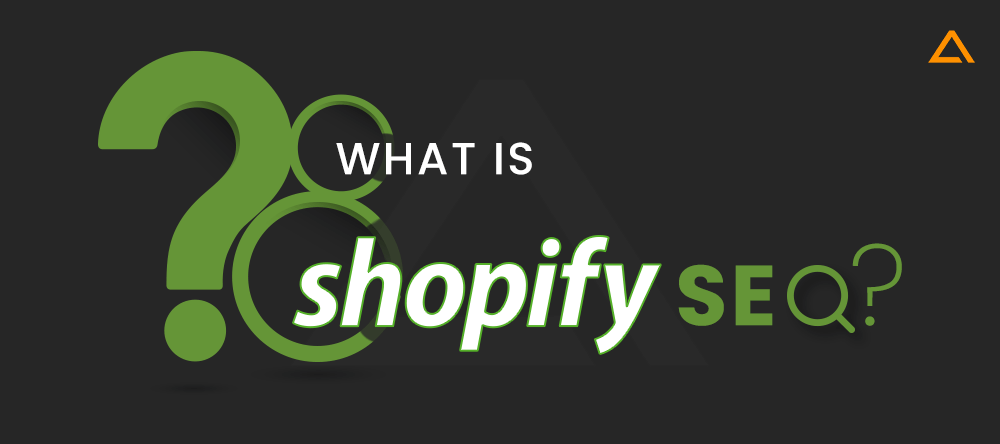
Shopify SEO refers to collective Shopify SEO tips and best practices to optimize your Shopify store for Google SERP and other search engines. While Shopify handles basic SEO pretty well, you will have to make extra efforts if you aim to reach the top Google rankings. The primary goal is to make your site more relevant to the user’s search intent and make google bots and crawlers believe your Shopify store has the closest offerings to their query.
Shopify SEO Features and Limitations
Before we go about improvising our Shopify store SEO, we should better understand what Shopify already does best in terms of SEO and what areas it lacks or can be improved.
Shopify SEO Features

Shopify understands the importance of SEO and provides some commendable SEO optimization features and workarounds. Here are some of the top Shopify SEO features:
Mobile Friendliness
Mobile Friendliness is a must for any eCommerce store these days. Insider Intelligence predicts m-commerce sales value to hit $620.97 billion, which accounts for 42.9% of overall eCommerce in the year 2024. Shopping online is more convenient on smartphones than on desktops and laptops.
Google seems to have taken note of it and generally ranks eCommerce stores with mobile: friendliness higher than ones that aren’t. Shopify comes in handy here as most Shopify themes are designed to be mobile-friendly and have a responsive design.
Autogenerated Robots.txt.file
Robots.txt.file is a crucial part of SEO for any website. It tells the search engines which pages you want them to crawl and which to avoid. The problem with keeping your entire Shopify store open for indexing is that google bots have a crawl budget for the billions of sites and pages added on the internet daily. Hence, you should be able to tell google bots not to crawl unnecessary pages such as admin, search or checkout pages.
For most ecommerce platforms, you need to manually create this robot’s.txt.file, which requires specific technical knowledge and can be taxing. Shopify autogenerates this file so non-technical merchants can also optimize their Shopify SEO.
Shopify SEO Apps
If you have previous experience with WooCommerce and WordPress, you would know how there are different plugins for different purposes and enhancing your ecommerce store. For instance, Yoast for SEO. Similarly, Shopify has an extensive library of ‘apps’ for various purposes that help improve Shopify SEO.
| Shopify SEO Practices | Shopify Apps |
| Image Optimization | AVADA SEO SUITE, Minifier SEO Image Optimizer, Variant Image Penguin |
| Fixing Broken Links | Dr. Link Check, Broken Link 404/301 Redirect, Ablestar Link Manager |
| SEO-Friendly Blogs | DropInBlog, Bloggle, Schema Plus for SEO, BlogHandy, Yoast SEO |
| Creating HTML Sitemap | SEO HTML and XML Sitemap, SEOlogy, XML HTML Sitemap Tool For SEO |
| Generating Rich Google Snippets | Hello Rich Snippets for SEO, Easy Rich Snippets for SEO, Schema & Breadcrumbs |
| Adding Image Alt Tag | SEO Optimize – Image Alt Text, Alt Text King, Auto Alt Text |
Also Read: Top Shopify Apps to Successfully Grow your eCommerce Store in 2022
Enabling 301 Redirects
301 redirects are crucial for search engine optimization. 301 redirects signal a permanent redirection from an old URL to a new one meant to replace the old URL that no longer exists. This means the old URL is being moved to the new URL, or the old URL has been updated. Users who access that old URL will be redirected to the new URL.
301 redirect can be especially beneficial when shifting platforms for your eCommerce site. For instance, you currently have an eCommerce site based on Magneto/WordPress or other eCommerce platforms. And you want to migrate your eCommerce store to Shopify. In such situations, the URLs of your existing eCommerce platform and Shopify platform don’t need to remain the same. They could lead to a 404 PAGE NOT FOUND error if they are different. But if you use 301 redirects, your pages will efficiently migrate to Shopify, keeping your existing domain authority and search rankings intact. This is a crucial SEO feature and is very easy to set up on your Shopify Store.
Ability to add Structured Data
Structured data is one of the most accurate ways of telling search engines about different aspects of your products. It helps the search engine understand product name, price and description. If Google correctly crawls your Shopify store with this structure data ready, it will be able to display your products better on its SERP.
Shopify SEO Limitations

While Shopify provides many SEO-friendly features, as we just saw, it also has certain limitations regarding certain aspects of SEO.
Sitemap cannot be edited
Shopify does automatically create sitemaps which work well for most use cases. However, one major drawback is that you cannot edit the sitemap. This can cause problems when your site grows and scales; it becomes more and more complex, and you cannot manually edit the sitemap to make sense of it.
Limited blogging features
Blogging is the best tool for SEO of any website based on any platform. Customers love reading informational bits and articles that provide valuable content, information, and comparison and act as a guide in their product buying journey. While Shopify has a blog section with decent SEO customizations, it doesn’t provide basic blogging features like:
- Adding a no-follow tag to outbound links
- Option to let users comment or share blogs on social media
- Gallery uploading
- CTA button and Maps insertion
Limited Structure Data Capabilities
Yes, Shopify provides primarily structured data. It helps Google better understand your product offerings to an extent. But it only allows Google to understand the attributes like product name, price and description. Suppose your Shopify store has products available in various sizes and colors. In that case, you won’t be able to provide those attributes to Google, which can be a lost opportunity in terms of conversion.
In Search to Hire Shopify Developers?
Hire certified dedicated Shopify developers From Aglowid to build a robust, scalable, and user-friendly eCommerce store.
Shopify SEO Guide – How to Improve SEO for Shopify
So, we understand the basics of Shopify SEO – the good and the bad. Now let’s go beyond and figure out how to improve your Shopify SEO ranking. SEO is a broad term and a collective group of practices throughout the Shopify Store, and hence it will be easier to talk about it when we break it into logical categories. Here is a detailed Shopify SEO guide that will help you optimize your Shopify store in no time:
Section 1: Basic Shopify SEO Checklist

Let’s start by quickly getting done with the primary and quick SEO fixes, which stay common between almost all platforms or are very easy to implement:
Investing in a custom domain name
When you create your Shopify store, your store gets a ‘ /myshopify.com’ URL. Hence, if your store name is HoliDates, your Shopify store URL would be ‘www.holidates/myshopify.com .’Now, what would be more convenient and appealing to you as a customer : ‘www.holidates/myshopify.com’ or ‘www.holidates.com’? Naturally, it has to be the latter. You can buy your preferred domain from Shopify or any third-party domain provider. Make sure the domain matches your brand niche, so there is an easy association that helps customers remember your site.
Choosing the suitable Shopify Theme
Most themes in Shopify can be customized for SEO and performance. However, depending on your niche and ratings given by other users, you should select a Shopify theme that is fast, responsive and SEO-friendly. Alternatively, you can also look for Shopify SEO services from a professional Shopify development firm specializing in creating custom Shopify themes.
Using Shopify Tools in the right balance
Shopify tools, as we discussed above, can be a great asset to have. Especially for easing most SEO-related tasks. However, most of these tools are expensive, available on a subscription basis and add to the store size, which impacts its loading speed. You should find the right balance between using Shopify’s essential SEO tools and doing other tasks manually by hiring a Shopify specialist if needed.
Section 2: Handling Keywords on your Shopify Store
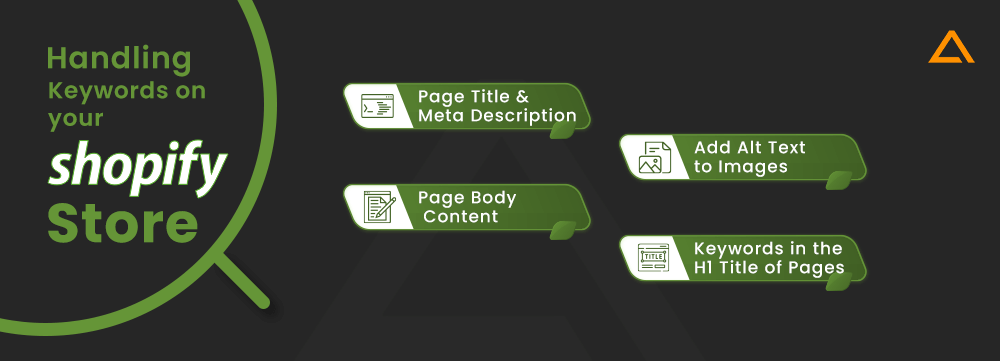
Keywords to SEO are what notes are to music. Although other factors affect SEO, such as linking, image alt attributes and more, without proper keyword insertion, all your efforts could go in vain. What exactly are keywords? Keywords are ‘catchphrases’ that often are a part of your target audience’s search queries that they enter on search engines to find services/products they want to buy. One of the most important considerations in keyword insertion is where and how often you should include your targeted keywords on your Shopify store.
Page Title and Meta Description
The Page Title is the first reference point for Google bots to determine if it justifies what the page is about. When users search for their intended queries on Google, the page title set by merchants shows up as clickable links. So, you need to be descriptive, focus on your keyword and appeal to the visitor to click on your link rather than others. Here are a few sure and short ways to optimize page titles:
- Make sure the title is unique, includes primary keywords and is descriptive
- If possible, stay within the character limit of 70 characters since anything beyond that might be shortened by search engines
- Ensure your title tag is easily comprehensible and appealing
- Include the highest priority keyword near the beginning of the page title
Next, we need to focus on meta descriptions. Meta description is the brief text you see below the page title on Google SERP. Its purpose is to provide additional information and gives the merchant a chance to give more value proposition to customers as to why their store is best suited for the customers’ needs. You can create meta descriptions for product pages, web pages, blog posts, and your collection pages.
Pro Tip: Often, merchants mistake leveraging meta descriptions as an opportunity to forcefully inject more keywords with no relevance to the page whatsoever. You should instead write meta descriptions in plain text and simple-to-understand sentences with your primary keyword placed in a way that makes sense.
Add Alt Text to Images
Images play a vital role in attracting customers and enticing them to make their final purchasing decision. How you photograph and place your images makes all the difference in conversions on your Shopify store. However, search engines, unfortunately, cannot understand or read your images. How do we fix this? Writing a descriptive alt text to help search engines find and understand the context of your images.
Adding alt text also helps make your store more accessible to people with visual impairments since the alt text describes all the essential features they should know about the picture. Alt text can be added for products, blog posts, and collection feature images.
Pro Tip – Use keywords from the page where the image is placed for writing its alt text. Instead of writing the alt text as marketing copy, you should only describe what appears in the image.
Page Body Content
Search engine crawlers compare your body text to your title text to ensure that your page is what it claims. Hence, you must ensure that your content is highly readable and includes long and short-tail keywords and some unique phrases. All the content should be relevant to the topic with little or less deviation. In an eCommerce site, you would need to write different kinds of content on different pages like Product Pages, Blogs, Collection Descriptions and more.
Pro Tip – Always focus on quality over quantity but keep at least 200 words of description for product pages and at least 500 words for blog posts so crawlers can easily comprehend your site’s relevance.
Keywords in the H1 Title of Pages
<h1> is an HTML tag generally used once on a page in the title section to describe what the page is mainly about. The title you give to all your pages is formatted in <h1> tag to generate the page’s header. Search engines use the header as the first point of contact to determine what the page is about. You should always include your main keywords in H1 tags.
Also Read: Shopify Setup Checklist for your eCommerce Store -Top 20 Steps to Check
Section 3: Shopify SEO best practices for B logs
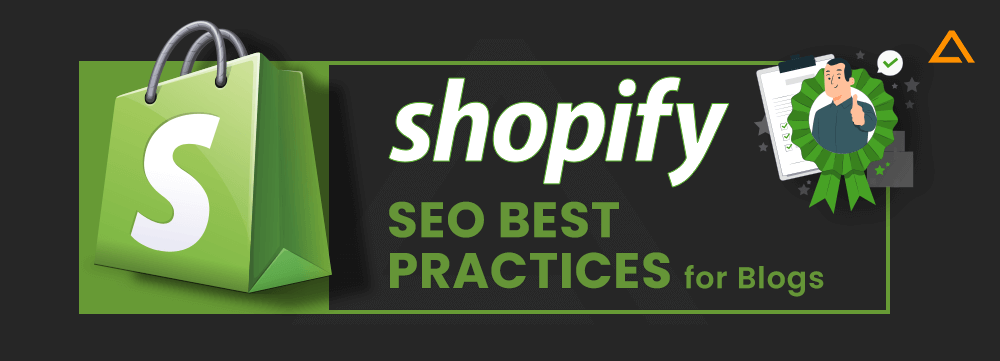
We briefly mentioned the limitations of the Shopify blogging section when it comes to SEO. However, many additional Shopify SEO best practices can be implemented in your blog section to drive better results and rank the Shopify store on higher SERP results.
Shopify Blogging SEO Considerations
Content Size: The first thing to consider and keep in mind is the size and length of your blogs. General Shopify blogs are at least 500 words long since anything below that might hardly get considered by crawlers as relevant or valuable content. And if you think about it, it won’t provide much value to the customer either. We recommend keeping your blog length around 700-1500 words or somewhere around that limit, depending on the intent and topic of the blog.
Content Intent: Next, you must understand the various blogs you should post on your eCommerce site. As an eCommerce merchant, your blogs mainly have two purposes – help visitors at the awareness stage of the funnel to reach the consideration stage or help customers who are at the consideration or preference stage to make a purchase decision. This means you would mainly write blogs that are informative or transactional.
Pro Tip –A good practice for improving your Shopify SEO through blogs is to conduct proper keyword research using popular keyword tools like SEMRush, Google Keyword Planner or other tools. Tools like SEMRush also indicate the intent of all keywords, which will help you plan your content outline around the tone and intent it is searched.
Modifying/Creating Content
There are only so many new blogs you can churn out every week, and while it is necessary to be on a hunt for the latest topics and cover them in your industry, you should not overlook the potential benefit of reworking old blogs.
For instance, you are a Shopify store selling comics.
You write a blog on a topic like ‘best comics in the US in 2021’. It performs well in the start but slowly starts losing traction towards the second quarter of 2022. In such a situation, you should first check all the comics you mentioned and if their popularity is still intact or if there are newer comics in 2022 that deserve mention. If yes, generally, there are two approaches you can take :
1. Update the previously written blog content and change the title to ‘best comics in the US in 2022’. 2. Write a part 2 blog and continue this as a series with all the new content in an entirely new blog.
Let’s talk about both options.
If you choose the first option and update your existing blog, it will give you the following benefits:
- Existing base of all the traffic and clicks your previous blog gathered
- Higher chances of gaining the ranks it lost on Google SERP
- Lesser work and labor into updating content than writing a new blog.
However, if you are taking this approach, do not add the year ‘2021’ in the ‘permalink’ of your URL. Because when you would update the permalink to ‘2022’, it would make the previous link obsolete (404), and you’d have to set up a 301 redirect to the new link.
If you choose the second option to make a series of blogs on the best comics in the US every year, it will entail the following benefits:
- If all your blogs in this collection are engaging and well-written, visitors will stay on your site longer, reducing your bounce rate scores, which can improve your overall Shopify store SEO
- You get to include more comics in your list, which might also help your site to show up in their related searches
- If your blogs also rank in the first 10 SERP results, such topics can generate high and recurring traffic as customers who have the will to purchase might want to compare the ones they are confused about repeatedly
If you choose this option, ensure that you include the year in the permalink for each blog ; otherwise, Google might penalize your Shopify store for having two blogs with the same links. In our experience, we don’t recommend creating a series as Google can still have difficulty prioritizing indexing for two similar pages with similar titles and URLs compared to updating the same blog with new content, as it is already indexed and has credible traffic.
If there is something new in the market, write a new blog or guide on it as soon as possible to get the first mover advantage.
Finding good Blog Topics – Shopify SEO Checklist
You can be entirely ready to write optimized blogs for your store, but people often get stuck at the most challenging stage is finding the right topic to write blogs on. Here is a quick checklist to come up with new blog ideas with ease :
- Identify valuable keywords in your niche
- Check their intent and divide blogs accordingly
- Check your site for existing content on such topics
- Optimize the existing content or create new content to cover it
- Upsell your blog by internally linking the products you mentioned in the blog to their respective product pages on your Shopify store to increase the chances of conversions.
Section 4: Product Page SEO Optimization
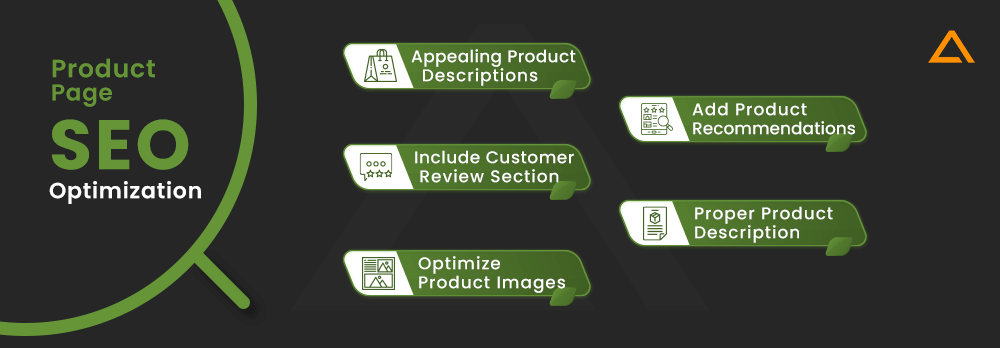
The product Page is the last wall between you and an interested buyer. You want to ensure that the visitor is convinced to buy the product or add it to the cart once they reach the product page. Here are some of the top Shopify SEO tips to optimize your product page:
Write appealing Product Descriptions
The product description has much to manage and include, yet it should not be overly crowded or worded. Sounds difficult, right? It doesn’t need to be if you have a proper strategy.
Here’s what you would want to include in the Product Description:
- Basic specifications about the product
- Benefits of using the product
- Targeted Keywords and LSI keywords twice or thrice
- Make use of descriptive adverbs and adjectives
- Include security standards if product requires/has it
Include Customer Review Section
Yes, we mentioned Shopify doesn’t provide support for adding customer reviews out-of-the-box. But you can integrate customer reviews to your product page by leveraging Shopify apps like Vitals, Loox Product Reviews & Photos and others. Most buyers prefer scrolling through the product review section before making their purchase decision, as the customer feedback section is considered the most genuine source of product efficiency since its written by other customers. Google also pays importance to customer reviews since it understands that the content in this section is user-generated.
Optimize Product Images
Generally, your product should be covered from all angles in the product page photos. This allows users to check the product’s quality, design and other aspects with finer details. Here are some of the best Shopify SEO best practices for optimizing product images:
- 360 videos of the product
- Photos in good lighting conditions and accurate colors
- Tutorial or informative video/infographics if product is complicated
- VR-like features like those of IKEA and Coca Cola
Pro Tip: Click high-res photos of your product and optimize their file size using any third-party photo compression tools or one of the Shopify apps to ensure your images are visually appealing but don’t slow down the site.
Add Group Purchase and Product Recommendations
Not keeping related products on the product page the visitor is on is a waste of an excellent opportunity for providing customers with more value to their shopping experience and increasing revenue per visitor. Just like you have POS counters in supermarkets, recommending related products near the CTA might also impulse them to buy those products, exceptionally if it’s packaged as a deal. Google bots also realize this improves the overall customer experience as users spend more time on such Shopify stores, which helps improve your overall SERP ranking.
Write Product Description as per Product Awareness
This is not necessarily a Shopify SEO tip that most brands or stores implement. However, it might be worthy of consideration as it helps stores with target audiences at different awareness levels. You can divide the product description is a tabular or clickable format with titles that resonate with the potential buyer.
If someone wants to learn about the product origin or benefits, you can have a section that mentions BENEFITS; if another customer is looking for industrial ratings, you can have all the legal and ecological information clubbed in another tab. This helps keep the product description neat and minimal while providing more value to all your users.
Section 5: Shopify Store SEO – Optimizing Site Structure
Site structure, especially in an ecommerce site, is very important to get right. How your pages are interlinked and how seamless the navigation is determined how many users first reach the product pages and find their desired products with the least friction. Your site structure should help the customer reach their desired place and not make it difficult.
Basic Shopify Site Structure

If you have a small to medium-scale Shopify store requirement, your site could follow a basic Shopify site structure such as:
As you can see, having such a structure helps your products be only two or three clicks from your home page. This provides convenience to the users as they can easily find their desired products. It also optimizes your Shopify SEO, as search engines can crawl your product pages within no time.
How does Shopify optimize your Site Structure?
Luckily Shopify takes care of site structure optimization to a great extent. In fact, for most users that don’t have very complex or enterprise-grade Shopify store setup requirements, the default structure would work just fine. However, there are also some best practices from your end to refine Shopify SEO further. Let’s first have a look at what Shopify already takes care of:
- Contents of your site are logically arranged in a hierarchy of categories
- URLs are written with standard characters that are readable and simple
- Pages avoid using iframes
How can you improve SEO on Shopify Site Structure?
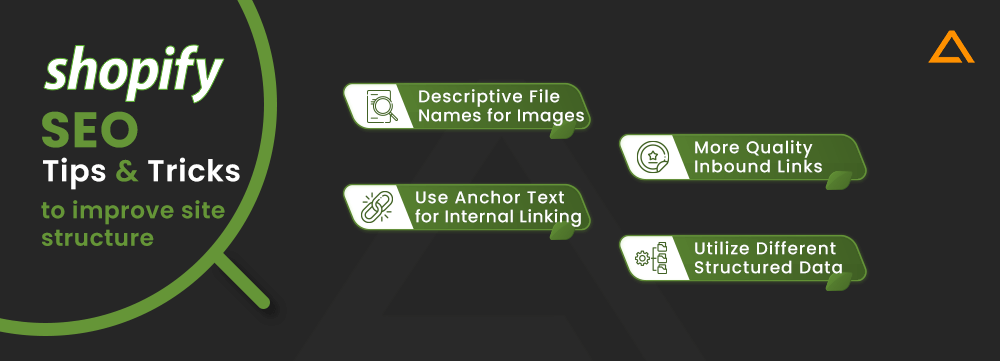
In addition to the factors that Shopify already takes care of, here are some Shopify SEO best practices for improvising your site structure even further:
Write descriptive file names for your site images.
Improving Shopify SEO starts way before you even enter your website. All the images you prepare for uploading on your website have a file name. If you optimize them using a third-party image resizer, chances are their file names would contain random characters placed together.
Google crawlers can read the file name of your uploaded images to derive more context about the picture. If you upload the images with random characters, it would barely make sense to the bots. Whereas, if you describe the image in the uploaded file, it will significantly improve your Shopify SEO. You can change the name of the image files by renaming them on your system before you upload them to your Shopify store.
Having more links directing to your Shopify store
You need to make google consider you a reliable and authoritative source of information/service provider for it to push you to higher SERP ranks. One of the most fundamental ways to do so is by building links from other websites in your niche to your site. Having many links to your Shopify store also increases your domain Authority.
Ways to increase links to your Shopify Store:
- Try reaching out to or getting published in listicles or other such articles
- Create a blog rolling plan with exciting topics and regularly maintain and upload blogs to get links naturally
- Build a two-way beneficial bond with other websites and request a link back
Use the correct anchor text for internal linking.
One of the most common SEO mistakes in Shopify or any other platform is placing internal links on irrelevant or vague anchor texts. Anchor text is the phrase on which you link relevant articles regarding that topic. The purpose is to help visitors redirect to that page if they wish to read further about that topic or take action depending on the anchor text.
Here is how a poorly managed anchor text look:
‘Also Read: How to create comics using online tools.’
What you should do instead:
‘Also Read: How to create comics using online tools.’ Utilize different Structured Data on your Shopify Store
Think of structure data as a direct communication line to Google. It is one of the most efficient ways to help Google understand, crawl and index your products, website content and other important aspects of your Shopify store.
So, what is structured data? It is bits of information organized in code snippets that aid google bots in getting a better understanding of what your website is about. It increases the chances of your blogs/product pages as rich snippets on Google. Such search results show more aspects than the title link and meta description. They also have – ratings, photos, pricing information and other structured information added via schema.
Here is what a rich snippet looks like:

Here you can see our SERP shows special features such as Rating, Votes and Pricing. Different Structured Data to add to your Shopify Store
| Types of Structured Data | Description |
| Product Structured Data | Provides Google with crucial information about your product, such as name, description and price. Most Shopify themes take care of this themselves |
| CollectionPage Structured Data | Since Shopify allows merchants to create collections, it is advisable to use the product markup schema for collection pages. It allows you to set the order of your products. |
| Article Structured Data | Used for blogs, this schema tells search engines that your blog is more editorial. Although it is the best blog schema, you can use the ‘BlogPosting’ schema to improvise Shopify Blog SEO. |
| BreadcrumbList Structured Data | This schema brings your Shopify Store’s breadcrumb internal links to Google’s attention. It informs Google that all the horizontal inks are part of that breadcrumb element. |
| AggregateRating | This schema allows Shopify merchants to show your product snippets show all reviews it has gathered along with average ratings. |
| FAQPage | This schema helps Google understand that the content under it is meant for the FAQ section, which will show on your rich snippet along with the page title and meta description if Google finds it relevant. |
Section 6: Hiding pages from Search Engine
If you have previous experience working on any eCommerce site, you would know the importance of setting up a robots.txt file. It is a fundamental element of any website’s SEO. Especially ecommerce sites are generally more significant and have a complex architecture compared to other kinds of websites. This can cause crawling priority problems.
You wouldn’t want to waste your google crawling budget on pages like About Us, Admin Pages and Checkout pages. So how do you hide such pages from google bots? By using robots.txt file! Shopify auto-generates this robots.txt file, so merchants don’t need to worry about it.
| Shopify Disallowed Crawling by Default | Description |
| Disallow: /search | Blocks internal site search |
| Disallow: /cart | Blocks the Shopping Cart page |
| Disallow: /checkout | Blocks the Checkout page |
| Disallow: /account | Blocks the account page |
| Disallow: /collections/*+* | Blocks duplicate category pages generated by the faceted navigation |
| Sitemap: [Sitemap Links] | References the sitemap.xml link |
Though the default parameters in Shopify’s robots.txt.file work well for most stores, Shopify users can now control how search engine bots see and index their stores via the ‘robots.txt.liquid’ file. This was announced on June 19, 2021, by Tobi Lutke (CEO of Shopify).
Why should I edit Shopify’s robot.txt.liquid file?
That’s a good question; let us help you understand the benefit of editing the robot.txt.file from an SEO point of view and editing the robots.txt.file helps Shopify SEO by:
Optimizing Crawl Budget
Crawl budget is one of the most essential terms to understand in SEO. It refers to the amount of time and resources a search engine assigns to crawl a website. Popular search engines like Google, Yahoo and Bing have to crawl almost all the websites available on the internet. They can naturally not crawl each website’s web page repetitively or frequently.
Hence, they rely on certain algorithms that decide how much time Google can allocate to each website. The time and resources allocated to crawl your Shopify store are called its crawl budget.
Your Shopify store has more pages or resources than your site’s crawl budget. In such a situation, some of your pages will be omitted from being crawled. This is the scenario with almost every website on the net. But the problem arises when pages that don’t provide much value to your Shopify store are crawled in priority to the ones you want. For instance, your ‘About US’ page is not as important as your ‘Product Landing Page’ to be crawled. Since ‘crawl budget’ is not precisely measurable, it is advised to optimize your crawl budget better to ensure the right pages are crawled.
How do you stop Google from crawling pages like About US, then? By editing the robots.txt.liquid file to instruct bots not to block specific directories or pages. This helps the chances of your desired pages to be crawled.
Repurposing Thin Content
Thin content is a technical term used to address a website’s content that provides almost no value to the user.
Generally, thin content is present on your Shopify website as:
- Scraped Content
- Automatically generated content
- Poorly written Affiliate Content
- Doorway Pages
- Duplicate Content
Initially, you could deal with thin content via noindex, follow method. This would request search engines follow all the links on that page but don’t display it as a SERP. Although this was a decent workaround, it still didn’t solve the problem of unwanted pages being crawled. Now using robots.txt.liquid template, you can entirely disallow such pages to be crawled altogether.
To understand how to edit robots.txt.liquid template, you can refer to the official Shopify Help Guide.
have a unique app Idea?
Hire Certified Developers To Build Robust Feature, Rich App And Websites.
Wrapping Up! With this, we conclude this ultimate guide on Shopify SEO. If you intend to choose Shopify for your ecommerce website development, follow the guidelines and tips/tricks to optimize your Shopify Store to increase your SERP ranks on Google.

